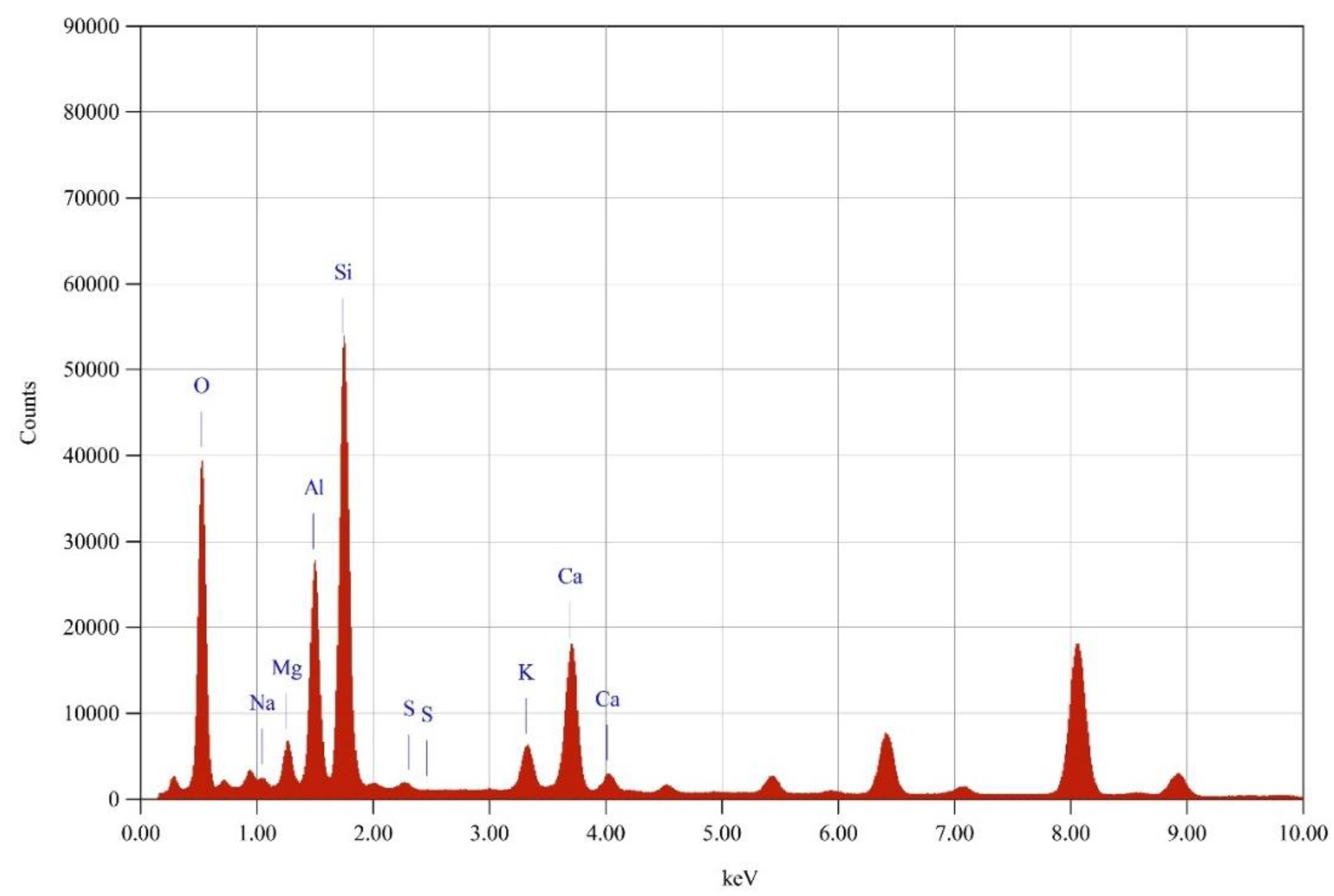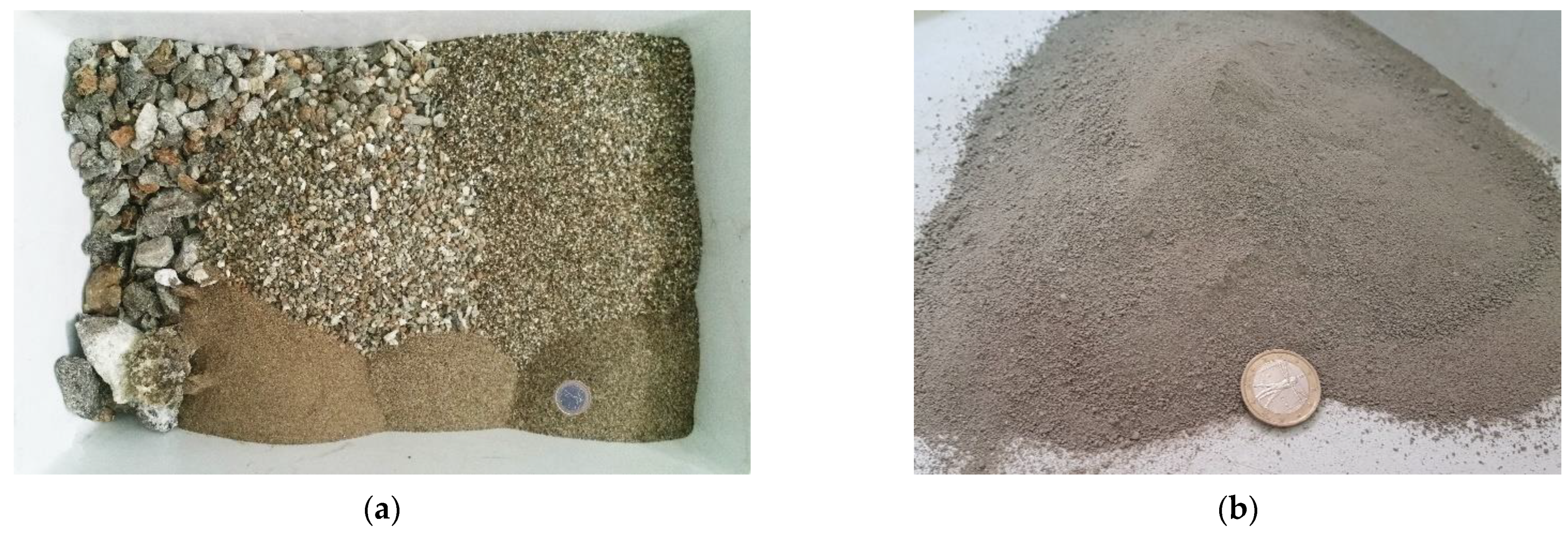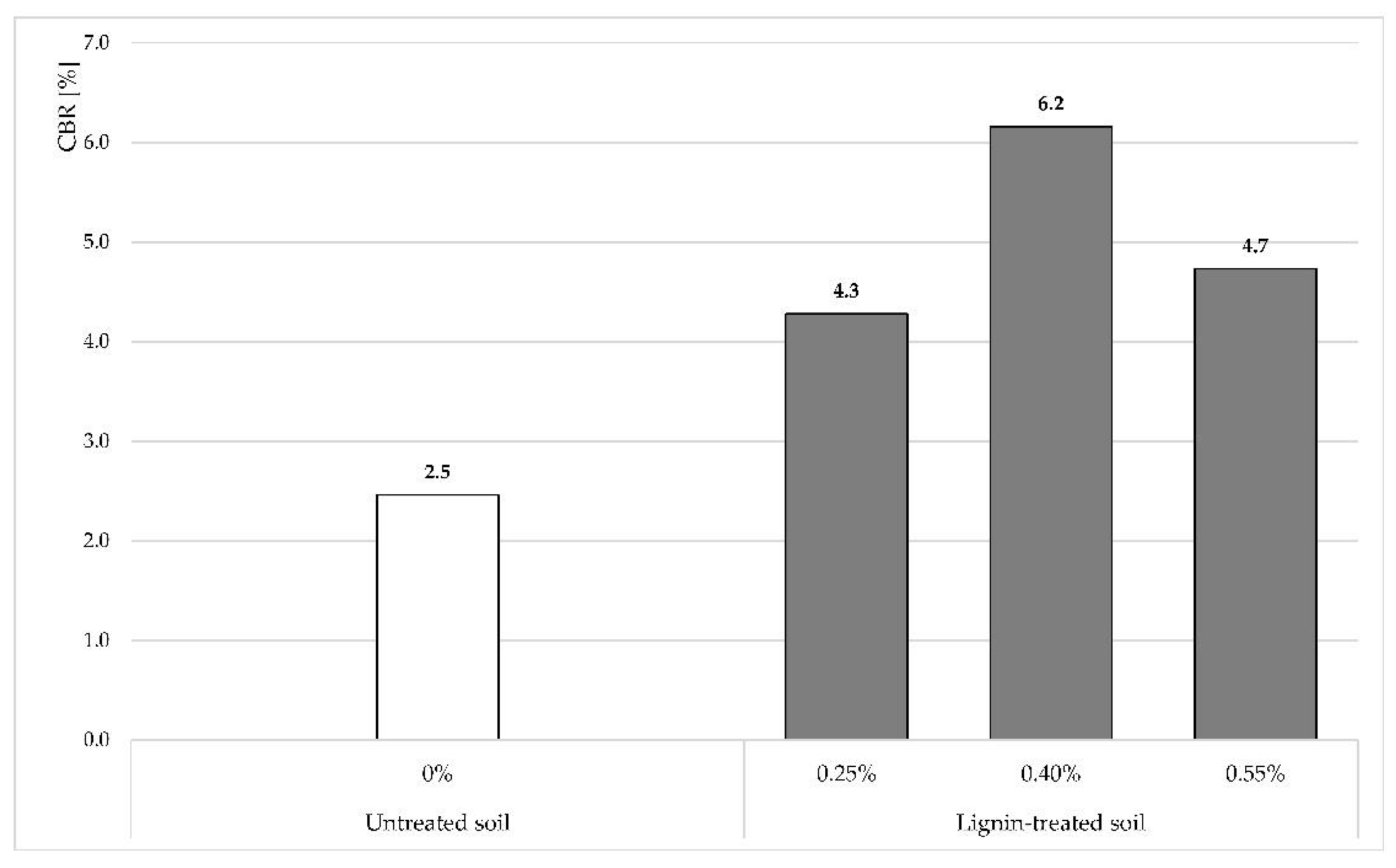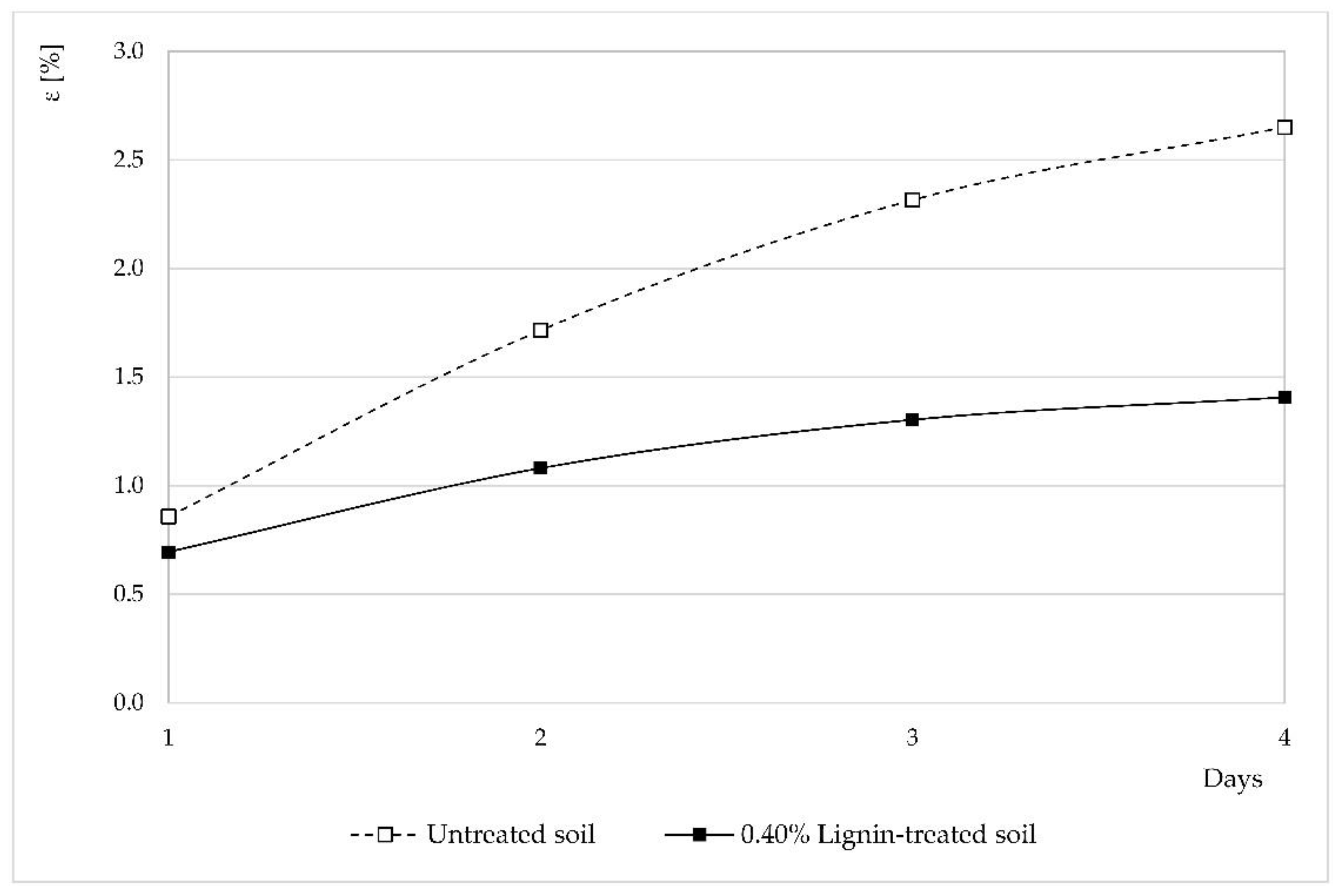An Eco-Sustainable Stabilization of Clayey Road Subgrades by Lignin Treatment: An Overview and a Comparative Experimental Investigation
Abstract
:1. Introduction
2. Literature Review
- dust suppression;
- unpaved roads stabilization;
- erosion resistance improvement (e.g., for road embankments);
- asphalt substitution as an environmentally friendly alternative to asphalt binders.
2.1. Lignin Utilization for Road Subgrades Stabilisation
- soil,
- lignin,
- mixing,
- curing and compaction.
- higher lignin content,
- an increase in curing time.
3. Materials and Methods
3.1. Materials
3.2. Tests and Methods
4. Results and Discussion
4.1. Effects of Lignin on Soil Mix S12
4.1.1. California Bearing Ratio (CBR) Test with Dry and Wet Conditioning
4.1.2. Swelling Behaviour of the Stabilised Soil
4.1.3. Unconfined Compressive Strength and Indirect Tensile Strength Tests
4.1.4. Effects on Atterberg Limits
4.2. Comparison between the Lignin-Treated Soil and the Lime-Treated Soil
5. Conclusions
- CBR tests carried out on specimens with three different types of curing showed that the addition of lignin improved the bearing capacity of the case study soil. In particular, after 7 days of air drying, the lignin-treated soil allowed recording an increase in the bearing of about 38% compared to the untreated soil. When the curing time included a soaking period of additional 4 days, the CBR values of the treated soil and untreated soil were approximately comparable. This latest result suggested that moisture conditions had an impact on the mechanical properties of the stabilised soil which lost the effect of lignin; thus, CBR values drastically decreased.
- The comparison between lignin-treated soil and lime-treated soil highlighted that the highest values of CBR were observed for the 2.5% lime-treated soil; water immersion caused a reduction in bearing capacity for both treated soils but the lime treatment allowed recording the lowest decrease. This result translated into the significantly lower water sensitivity of the lime-stabilised soil compared to the lignin-stabilised soil.
- The analysis of CII values recorded for the cured and soaked specimens suggested that lime addition continued to strongly impact the bearing capacity of the soil. The value of ∆CII, which was more than 50%, reflected the poor ability of lignin to upgrade the bearing capacity of the soil in wet conditions compared to lime. For this reason, the use of lignin must be carefully considered when wet soil conditions are present (e.g., in the presence of an aquifer, water infiltration into the pavement structure, wet environments).
- The immersion in water as part of the curing of the samples for the CBR test allowed investigating the swelling behaviour of the stabilised soil. The test showed that the presence of lignin helped in controlling the swelling potential of this type of soil. In particular, the values of the swelling strain were lower than the values recorded for the lime-treated soil.
- the application of lignin with different types of extraction processes and sources;
- the application of clayey soils with different properties;
- other types of tests for the characterization of the stabilised soil.
Author Contributions
Funding
Institutional Review Board Statement
Informed Consent Statement
Acknowledgments
Conflicts of Interest
References
- National Academies of Sciences, Engineering, and Medicine. Recommended Practice for Stabilization of Subgrade Soils and Base Materials; The National Academies Press: Washington, DC, USA, 2009. [Google Scholar] [CrossRef]
- Ciampa, D.; Cioffi, R.; Colangelo, F.; Diomedi, M.; Farina, I.; Olita, S. Use of Unbound Materials for Sustainable Road Infrastructures. Appl. Sci. 2020, 10, 3465. [Google Scholar] [CrossRef]
- Geiman, C.M.; Filz, G.M.; Brandon, T.L.; Plaut, R.H. Stabilization of Soft Clay Subgrades in Virginia Phase I Laboratory Study; Virginia Tech: Blacksburg, VA, USA, 2005. [Google Scholar]
- Danyluk, L.S. Stabilization of Fine-Grained Soil for Road and Airfield Construction. Special Report 86-21; U.S. Army Cold Regions Research and Engineering Laboratory: Hanover, NH, USA, 1986. [Google Scholar]
- Little, D.; Thompson, M.; Terrell, R.; Epps, J.; Barenberg Dallas, E.N. Soil Stabilization for Roadways and Airfields; Engineering & Services Laboratory Air Force Engineering & Services Center: Tyndall Air Force Base, FL, USA, 1987. [Google Scholar]
- Lim, S.M.; Wijeyesekera, D.C.; Lim, A.J.M.S.; Bakar, I.B.H. Critical Review of Innovative Soil Road Stabilization Techniques. Int. J. Eng. Adv. Technol. 2014, 3, 204–211. [Google Scholar]
- Neves, J.; Lima, H.; Gonçalves, M. A Numerical Study on the Implications of Subgrade Reinforcement with Geosynthetics in Pavement Design. Procedia Eng. 2016, 143, 888–895. [Google Scholar] [CrossRef] [Green Version]
- Ramdas, V.M.; Mandree, P.; Mgangira, M.; Mukaratirwa, S.; Lalloo, R.; Ramchuran, S. Review of Current and Future Bio-Based Stabilisation Products (Enzymatic and Polymeric) for Road Construction Materials. Transp. Geotech. 2021, 27, 100458. [Google Scholar] [CrossRef]
- Robnett, Q.L. Use of Marginal Materials in Highway Construction. 1980. Available online: https://docs.lib.purdue.edu/cgi/viewcontent.cgi?article=3183&context=roadschool (accessed on 24 July 2021).
- Praticò, F.G.; Vaiana, R.; Giunta, M.; Iuele, T.; Moro, A. Recycling PEMs Back to TLPAs: Is That Possible notwithstanding RAP Variability? In Proceedings of the Applied Mechanics and Materials; Trans Tech Publications Ltd.: Bäch, Switzerland, 2013; Volume 253–255, pp. 376–384. [Google Scholar]
- Vukićević, M.; Marjanović, M.; Pujević, V.; Jocković, S. The Alternatives to Traditional Materials for Subsoil Stabilization and Embankments. Materials 2019, 12, 3018. [Google Scholar] [CrossRef] [Green Version]
- Praticò, F.G.; Casciano, A.; Tramontana, D. Pavement Life-Cycle Cost and Asphalt Binder Quality: Theoretical and Experimental Investigation. J. Constr. Eng. Manag. 2010, 137, 99–107. [Google Scholar] [CrossRef]
- Vijayakumar, A.; Kumar, S.N.; Tejareddy, P.A. Utilization of Waste Materials for the Strengthening of Pavement Subgrade-a Research. Int. J. Innov. Technol. Explor. Eng. 2019, 8, 209–212. [Google Scholar]
- Xu, G.; Wang, H.; Zhu, H. Rheological Properties and Anti-Aging Performance of Asphalt Binder Modified with Wood Lignin. Constr. Build. Mater. 2017, 151, 801–808. [Google Scholar] [CrossRef]
- Doherty, W.O.S.; Mousavioun, P.; Fellows, C.M. Value-Adding to Cellulosic Ethanol: Lignin Polymers. Ind. Crop. Prod. 2011, 33, 259–276. [Google Scholar] [CrossRef] [Green Version]
- Bajwa, D.S.; Pourhashem, G.; Ullah, A.H.; Bajwa, S.G. A Concise Review of Current Lignin Production, Applications, Products and Their Environment Impact. Ind. Crop. Prod. 2019, 139, 111526. [Google Scholar] [CrossRef]
- Bell, F.G. Lime Stabilization of Clay Minerals and Soils. Eng. Geol. 1996, 42, 223–237. [Google Scholar] [CrossRef]
- Yoder, E. Principles of Soil Stabilization: Technical Report. 1957. Available online: https://docs.lib.purdue.edu/cgi/viewcontent.cgi?article=1877&context=jtrp (accessed on 11 July 2021).
- Nik Daud, N.N.; Jalil, F.N.A.; Celik, S.; Albayrak, Z.N.K. The Important Aspects of Subgrade Stabilization for Road Construction. IOP Conf. Ser. Mater. Sci. Eng. 2019, 512, 012005. [Google Scholar] [CrossRef]
- Davis, E.H. The California Bearing Ratio Method for the Design of Flexible Roads and Runways. Géotechnique 1949, 1, 249–263. [Google Scholar] [CrossRef]
- Guyer, J.P. An Introduction to Soil Stabilization in Pavements. Available online: https://www.cedengineering.com/userfiles/An%20Introduction%20to%20Soil%20Stabilization%20for%20Pavements%20R1.pdf (accessed on 3 September 2021).
- American Association of State Highway and Transportation Officials (AASHTO). Guide for Design of Pavement Structures; AASHTO: Washington, DC, USA, 1993. [Google Scholar]
- Rasul, J.M.; Burrow, M.P.N.; Ghataora, G.S. Consideration of the Deterioration of Stabilised Subgrade Soils in Analytical Road Pavement Design. Transp. Geotech. 2016, 9, 96–109. [Google Scholar] [CrossRef]
- Dawson, A.R.; Correia, A.G. The Effects of Subgrade Clay Condition on the Structural Behaviour of Road Pavements; CRC Press Balkema: Rotterdam, The Netherlands, 1996. [Google Scholar]
- Sariosseiri, F.; Muhunthan, B. Effect of Cement Treatment on Geotechnical Properties of Some Washington State Soils. Eng. Geol. 2009, 104, 119–125. [Google Scholar] [CrossRef]
- Zhang, T.; Yang, Y.L.; Liu, S.Y. Application of Biomass By-Product Lignin Stabilized Soils as Sustainable Geomaterials: A Review. Sci. Total Environ. 2020, 728, 138830. [Google Scholar] [CrossRef] [PubMed]
- Smaida, A.; Mekerta, B.; Gueddouda, M.K. Physico-Mechanical Stabilization of a High Swelling Clay. Constr. Build. Mater. 2021, 289, 123197. [Google Scholar] [CrossRef]
- Petry, T.M.; Little, D.N. Review of Stabilization of Clays and Expansive Soils in Pavements and Lightly Loaded Structures—History, Practice, and Future. J. Mater. Civ. Eng. 2002, 14, 447–460. [Google Scholar] [CrossRef]
- Edil, T.B.; Benson, C.H.; Bin-Shafique, M.; Tanyu, B.F.; Kim, W.-H.; Senol, A. Field Evaluation of Construction Alternatives for Roadways over Soft Subgrade. Transp. Res. Rec. J. Transp. Res. Board 2002, 1786, 36–48. [Google Scholar] [CrossRef]
- Zhu, Z.D.; Liu, S.Y. Utilization of a New Soil Stabilizer for Silt Subgrade. Eng. Geol. 2008, 97, 192–198. [Google Scholar] [CrossRef]
- Bheemasetti, T.V.; Pedarla, A.; Puppala, A.J.; Acharya, R. Design of Sustainable High-Volume Pavements Using Controlled Low-Strength Material from Native Soil. Transp. Res. Rec. J. Transp. Res. Board 2015, 2509, 10–17. [Google Scholar] [CrossRef]
- Fedele, R.; Pratico, F.G.; Carotenuto, R.; Giuseppe Della Corte, F. Instrumented Infrastructures for Damage Detection and Management. In Proceedings of the 5th IEEE International Conference on Models and Technologies for Intelligent Transportation Systems, MT-ITS 2017, Naples, Italy, 26–28 June 2017; pp. 526–531. [Google Scholar] [CrossRef]
- Ardah, A.; Chen, Q.; Abu-Farsakh, M. Evaluating the Performance of Very Weak Subgrade Soils Treated/Stabilized with Cementitious Materials for Sustainable Pavements. Transp. Geotech. 2017, 11, 107–119. [Google Scholar] [CrossRef]
- Okyay, U.S.; Dias, D. Use of Lime and Cement Treated Soils as Pile Supported Load Transfer Platform. Eng. Geol. 2010, 114, 34–44. [Google Scholar] [CrossRef]
- Kestler, M.A. Stabilization Selection Guide for Aggregate-and Native-Surfaced Low-Volume Roads. 2009. Available online: https://www.fs.fed.us/t-d/pubs/pdf/08771805.pdf (accessed on 11 September 2021).
- Hicks, R.G. Evaluation of Soil Stabilization Practices in Alaska. Phase I-Interim Report. 2001. Available online: https://dot.alaska.gov/stwddes/research/assets/pdf/fhwa_ak_rd_01_06a.pdf (accessed on 13 May 2021).
- Woolley, W.R. Fundamentals of Road and Subgrade Stabilization. Available online: https://docs.lib.purdue.edu/cgi/viewcontent.cgi?article=2176&context=roadschool (accessed on 24 May 2021).
- Tingle, J.S.; Newman, J.K.; Larson, S.L.; Weiss, C.A.; Rushing, J.F. Stabilization Mechanisms of Nontraditional Additives. Transp. Res. Rec. J. Transp. Res. Board 2007, 1989-2, 59–67. [Google Scholar] [CrossRef]
- Das, B.M. Chemical and Mechanical Stabilization. In Proceedings of the Transportation in the New Millennium; Transportation Research Board: Washington, DC, USA, 2000. [Google Scholar]
- Lim, S.M.; Wijeyesekera, D.; Yek, C.S. Soil Stabilisation for Rural Roads from a Geotechnical Perspective. In Proceedings of the 25th World Road CongressWorld Road Association (PIARC), Seoul, Korea, 2–6 November 2015. [Google Scholar]
- Maher, M.; Marshall, C.; Harrison, F.; Baumgaertner, K. Context Sensitive Roadway Surfacing Selection Guide; No. FHWA-CFL/TD-05-004; Federal Highway Administration, Central Federal Lands Highway Division: Vancouver, WA, USA, 2005.
- Aro, T.; Fatehi, P. Production and Application of Lignosulfonates and Sulfonated Lignin. ChemSusChem 2017, 10, 1861–1877. [Google Scholar] [CrossRef]
- Bolander, P. Laboratory Testing of Nontraditional Additives for Stabilization of Roads and Trail Surfaces. Transp. Res. Rec. J. Transp. Res. Board 1999, 1652, 24–31. [Google Scholar] [CrossRef]
- Russell, M.L. Stabilizing Sand Roads with Wood Products and Byproducts. Transp. Res. Rec. J. Transp. Res. Board 2015, 2473, 164–171. [Google Scholar] [CrossRef]
- Rummer, B.; Archer, H.; Hebner, G. Improving Stability of Low-Volume Forest Roads Using a Lignin-Based Emulsion. In Proceedings of the 24th Annual COFE Meeting, Showshoe, WV, USA, 15–19 July 2001; pp. 81–87. [Google Scholar]
- Mazuch, L.; Tiscot, O.R. Follow up of a New Method of Base Course Stabilization Using a Combination of Emulsified Bitumen and Lignosulphate as a Binder. In Proceedings of the Roads and Transportation Association of Canada Conference, Calgary, AB, Canada, 17–21 November 1989; Volume 1. [Google Scholar]
- Indraratna, B.; Athukorala, R.; Vinod, J. Estimating the Rate of Erosion of a Silty Sand Treated with Lignosulfonate. J. Geotech. Geoenviron. Eng. 2013, 139, 701–714. [Google Scholar] [CrossRef] [Green Version]
- Norgbey, E.; Huang, J.; Hirsch, V.; Liu, W.J.; Wang, M.; Ripke, O.; Li, Y.; Takyi Annan, G.E.; Ewusi-Mensah, D.; Wang, X.; et al. Unravelling the Efficient Use of Waste Lignin as a Bitumen Modifier for Sustainable Roads. Constr. Build. Mater. 2020, 230, 116957. [Google Scholar] [CrossRef]
- Sundstrom, D.W.; Kiel, H.E.; Daubenspeck, T.H. Use of Byproduct Lignins as Extenders in Asphalt. Ind. Eng. Chem. Prod. Res. Dev. 1983, 22, 496–500. [Google Scholar] [CrossRef]
- Wang, H.; Derewecki, K. Rheological Properties of Asphalt Binder Partially Substituted with Wood Lignin. In Proceedings of the 2013 Airfield and Highway Pavement Conference, American Society of Civil Engineers, Los Angeles, CA, USA, 9–12 June 2013; pp. 977–986. [Google Scholar]
- Sinha, S.P.; Davidson, D.T.; Hoover, J.M. Lignins as Stabilizing Agents for Northeastern Iowa Loess. In Proceedings of the Iowa Academy of Science; 1957; Volume 64, pp. 314–348. Available online: https://scholarworks.uni.edu/pias/vol64/iss1/36 (accessed on 3 July 2021).
- AASHTO. Standard Specification for Classification of Soils and Soil–Aggregate Mixtures for Highway Construction Purposes. AASHTO M145-91 (2008); AASHTO: Washington, DC, USA, 2008. [Google Scholar]
- Santoni, R.L.; Tingle, J.S.; Webster, S.L. Stabilization of Silty Sand with Nontraditional Additives. Transp. Res. Rec. J. Transp. Res. Board 2002, 1787, 61–70. [Google Scholar] [CrossRef] [Green Version]
- Zhu, F.; Li, J.; Jiang, W.; Zhang, S.; Dong, W. Freeze-Thaw Performance of Silt Sand Treated with Lignin. Adv. Civ. Eng. 2021, 2021, 6639268. [Google Scholar] [CrossRef]
- Uzer, A.U. Use of Biofuel Co-Product for Pavement Geo-Materials Stabilization. In Proceedings of the Procedia Engineering; Elsevier Ltd.: Amsterdam, The Netherlands, 2015; Volume 125, pp. 685–691. [Google Scholar]
- Zhang, T.; Liu, S.; Cai, G.; Puppala, A.J. Experimental Investigation of Thermal and Mechanical Properties of Lignin Treated Silt. Eng. Geol. 2015, 196, 1–11. [Google Scholar] [CrossRef]
- Cai, G.; Zhang, T.; Liu, S.; Li, J.; Jie, D. Stabilization Mechanism and Effect Evaluation of Stabilized Silt with Lignin Based on Laboratory Data. Mar. Georesources Geotechnol. 2016, 34, 331–340. [Google Scholar] [CrossRef]
- Zhang, T.; Cai, G.; Liu, S. Application of Lignin-Based by-Product Stabilized Silty Soil in Highway Subgrade: A Field Investigation. J. Clean. Prod. 2017, 142, 4243–4257. [Google Scholar] [CrossRef]
- Yang, B.; Ceylan, H.; Gopalakrishnan, K.; Kim, S. Evaluation of the Freeze and Thaw Durability of Road Soils Stabilized with a Biofuel Co-Product; American Society of Civil Engineers (ASCE): Reston, VA, USA, 2017; pp. 125–133. [Google Scholar]
- Zhang, T.; Cai, G.; Liu, S. Application of Lignin-Stabilized Silty Soil in Highway Subgrade: A Macroscale Laboratory Study. J. Mater. Civ. Eng. 2018, 30, 04018034. [Google Scholar] [CrossRef]
- Zhang, T.; Cai, G.; Liu, S. Reclaimed Lignin-Stabilized Silty Soil: Undrained Shear Strength, Atterberg Limits, and Microstructure Characteristics. J. Mater. Civ. Eng. 2018, 30, 04018277. [Google Scholar] [CrossRef]
- Li, Y.; Zhang, Y.; Ceylan, H.; Kim, S. In Situ Evaluation of Using Lignosulfonate for Subgrade Stabilization; American Society of Civil Engineers (ASCE): Reston, VA, USA, 2020; pp. 592–600. [Google Scholar]
- Kim, S.; Gopalakrishnan, K.; Ceylan, H. Moisture Susceptibility of Subgrade Soils Stabilized by Lignin-Based Renewable Energy Coproduct. J. Transp. Eng. 2012, 138, 1283–1290. [Google Scholar] [CrossRef] [Green Version]
- Gopalakrishnan, K.; Ceylan, H.; Kim, S. Renewable Biomass-Derived Lignin in Transportation Infrastructure Strengthening Applications. Int. J. Sustain. Eng. 2013, 6, 316–325. [Google Scholar] [CrossRef] [Green Version]
- Tingle, J.S.; Santoni, R.L. Stabilization of Clay Soils with Nontraditional Additives. Transp. Res. Rec. J. Transp. Res. Board 2003, 1819, 72–84. [Google Scholar] [CrossRef]
- Aschuri, I.; Yamin, A. The Use of by Product-Waste Materials on Road Pavement Conctruction in Indonesia. Proc. East. Asia Soc. Transp. Stud. 2011, 2011, 283. [Google Scholar] [CrossRef]
- Chavali, R.V.P.; Reshmarani, B. Characterization of Expansive Soils Treated with Lignosulfonate. Int. J. Geo-Eng. 2020, 11, 1–10. [Google Scholar] [CrossRef]
- Alazigha, D.P.; Indraratna, B.; Vinod, J.S.; Ezeajugh, L.E. The Swelling Behaviour of Lignosulfonate-Treated Expansive Soil. Proc. Inst. Civ. Eng.-Ground Improv. 2016, 169, 182–193. [Google Scholar] [CrossRef] [Green Version]
- Gow, A.J.; Davidson, D.T.; Sheeler, J.B. Relative Effects of Chlorides, Lignosulfonates and Molasses on Properties of a soil-Aggregate Mix. Highway Res. Board Bull. 1961, 282. Available online: https://trid.trb.org/view/122449 (accessed on 19 September 2021).
- Caputo, P.; Loise, V.; Ashimova, S.; Teltayev, B.; Vaiana, R.; Oliviero Rossi, C. Inverse Laplace Transform (ILT)NMR: A Powerful Tool to Differentiate a Real Rejuvenator and a Softener of Aged Bitumen. Colloids Surfaces A Physicochem. Eng. Asp. 2019, 574, 154–161. [Google Scholar] [CrossRef]
- Kumari, N.; Mohan, C. Basics of Clay Minerals and Their Characteristic Properties. Clay Clay Miner. 2021. [Google Scholar] [CrossRef]
- Prothmann, J.; Sun, M.; Spégel, P.; Sandahl, M.; Turner, C. Ultra-High-Performance Supercritical Fluid Chromatography with Quadrupole-Time-of-Flight Mass Spectrometry (UHPSFC/QTOF-MS) for Analysis of Lignin-Derived Monomeric Compounds in Processed Lignin Samples. Anal. Bioanal. Chem. 2017, 409, 7049–7061. [Google Scholar] [CrossRef] [PubMed] [Green Version]
- Reale, S.; di Tullio, A.; Spreti, N.; de Angelis, F. Mass Spectrometry in the Biosynthetic and Structural Investigation of Lignins. Mass Spectrom. Rev. 2004, 23, 87–126. [Google Scholar] [CrossRef]
- Bowman, A.S.; Asare, S.O.; Lynn, B.C.; Bert Lynn, C.C. Matrix-Assisted Laser Desorption/Ionization Time-of-Flight Mass Spectrometry Analysis for Characterization of Lignin Oligomers Using Cationization Techniques and 2,5-Dihydroxyacetophenone (DHAP) Matrix. Rapid Commun. Mass Spectrom. 2019, 33, 811–819. [Google Scholar] [CrossRef]
- Letourneau, D.R.; Volmer, D.A. Mass Spectrometry-Based Methods for the Advanced Characterization and Structural Analysis of Lignin: A Review. Mass Spectrom. Rev. 2021. [Google Scholar] [CrossRef]
- European Committee For Standardization. EN 13286-47:2012. Unbound and Hydraulically Bound Mixtures—Part 47: Test Method for the Determination of California Bearing Ratio, Immediate Bearing Index and Linear Swelling; European Committee For Standardization: Brussels, Belgium, 2012. [Google Scholar]
- ASTM. D4546: Standard Test Methods for One-Dimensional Swell or Collapse of Cohesive Soils; ASTM: West Conshohocken, PA, USA, 2008. [Google Scholar]
- European Committee For Standardization. EN 13286-41:2006. Miscele Non Legate e Legate Con Leganti Idraulici—Parte 41: Metodo Di Prova per La Determinazione Della Resistenza a Compressione Di Miscele Legate Con Leganti Idraulici; European Committee For Standardization: Brussels, Belgium, 2006. [Google Scholar]
- European Committee For Standardization. EN 13286-42:2006. Miscele Non Legate e Legate Con Leganti Idraulici—Parte 42: Metodo Di Prova per La Determinazione Della Resistenza a Trazione Indiretta Di Miscele Legate Con Leganti Idraulici; European Committee For Standardization: Brussels, Belgium, 2006. [Google Scholar]
- European Committee For Standardization. EN ISO 17892-12:2018. Indagini e Prove Geotecniche—Prove Di Laboratorio Sui Terreni—Parte 12: Determinazione Dei Limiti Liquidi e Plastici; European Committee For Standardization: Brussels, Belgium, 2018. [Google Scholar]
- Scesi, L.; Papini, M.; Gattinoni, P. Geologia Applicata. Vol. 1: Il Rilevamento Geologico-Tecnico, 2nd ed.; CEA: Rome, Italy, 2006. [Google Scholar]








| AASHTO Soil Classification | Maximum Dry Unit Weight (γd, max) (kg/m3) | Main Properties of the Stabilizing Agent | Additive Content (%) | References |
|---|---|---|---|---|
| A-2 | 2260 | Lignosulfonate; powder | 2.9, 5 (*), 8 | [53] |
| – | Lignin; by-product of a paper mill; powder | 3, 6 (*), 9, 12, 15 | [54] | |
| A-4 | 1631–1839 | 5% lignin + 50% hemicellulose + 20% cellulose + 25% other components; by-product of ethanol production (corn) | 12 | [55] |
| 1720 | 80% lignin + 10% cellulose + impurities; by-product of the paper manufacturing industry; powder | 2, 5, 8, 12 (*), 15 | [56] | |
| 1720 | 60–70% lignin + water + other components; by-product of commercial biomass conversion; powder | 2, 5, 8, 12 (*), 15 | [57] | |
| 1720 | Lignin; by-product from a paper mill; powder | 8, 12 (*) | [58] | |
| 1631 | 5% lignin + 25% water + 5–10% gases + 4% char + 35–41% aldehydes; by-product of commercial biomass conversion; liquid | 12 | [59] | |
| 1631 | 5% lignin + 50% hemicellulose + 20% cellulose + other components; by-product of ethanol production (corn); powder | 12 | ||
| 1631 | 40% lignin-derived phenolic oligomers + 20% water + 40% other components; liquid | 12 | ||
| 1720 | Lignin; by-product of the the paper manufacturing industry; powder | 2, 5, 8, 12 (*), 15 | [60] | |
| 1720 | Lignin; by-product of the paper manufacturing industry; powder | 2, 5, 8, 12 | [61] | |
| – | Lignosulfonate; co-product of the paper pulp industry; liquid | 2.5 | [62] | |
| A-6 | 1691 | 25% lignin + 25% water; by-product of commercial biomass conversion (agricultural residues); liquid | 12 | [63] |
| 1691 | 5% lignin + 50% hemicellulose + 20% cellulose + other components; by-product of ethanol production (corn); powder | 12 | ||
| 1693 | 25% lignin + 25% water + 5–10% gases + 4% char + 35–41% aldehydes; by-product of commercial biomass conversion (forest and agricultural residues); liquid | 1, 3, 6, 12 (*), 15 | [64] | |
| 1858 | Lignosulfonate; powder | 3.37, 5 (*), 8 | [65] | |
| A-7 | 1100–1400 | Lignin; by-product from a paper mill; liquid | 1, 2, 3, 4, 5 | [66] |
| 1420–1690 | Lignosulfonate; powder | 0.5, 1, 2, 4 | [67] |
| S1 | Soil 1 | S2 | Clayey Soil | Resultant Soil Mix S1 + S2 = S12 | |
|---|---|---|---|
| Particle size distribution (%) | |||
| Gravel (2–75 mm) | 48.6 | - | 28.2 |
| Coarse sand (0.425–2 mm) | 22.5 | - | 13.1 |
| Fine sand (0.075–0.425 mm) | 14.5 | - | 8.4 |
| Silt and clay (<0.075 mm) | 14.4 | 100 | 50.3 |
| Atterberg limits (%) | |||
| Liquid limit (LL) | - | 52 | 38 |
| Plasticity limit (PL) | - | 22 | 20 |
| Plasticity index (PI) | NP * | 30 | 18 |
| Proctor compaction test | |||
| Optimum water content (wopt) (%) | 6.02 | - | 13.4 |
| Maximum dry unit weight (γd,max) (kg/m3) | 2290 | - | 1910 |
| AASHTO soil classification | A-3 | A-7-6 | A-6 |
| Lignin Content (%) | CBR (%) | Water Sensitivity Ratio (%) | |
|---|---|---|---|
| Curing Time | |||
| 7 Days of Air Drying | 7 Days of Air Drying + 4 Days of Soaking | ||
| 0% (untreated soil) | 18.2 | 2.2 | 12.1 |
| 0.40% | 25.1 | 3.4 | 13.5 |
| Lignin Content (%) | Tests | |
|---|---|---|
| Curing Time: 7 Days of Air Drying | ||
| ITS (daN/cm2) | UCS (N/mm2) | |
| 0% (untreated soil) | 1.1 | 1.4 |
| 0.40% | 1.2 | 1.6 |
| Lignin Content (%) | Atterberg Limits | ||
|---|---|---|---|
| Liquid Limit (LL) | Plastic Limit (PL) | Plasticity Index (PI) | |
| 0% (untreated soil) | 38 | 20 | 18 |
| 0.40% | 41 | 21 | 20 |
| Stabilizing Agent Content (%) and Type | CBR (%) | CII (%) | |
|---|---|---|---|
| 0 days of curing | |||
| 0% (untreated soil) | 2.5 | - | |
| 0.4% lignin-treated soil | 6.2 | CIILg−U = +60 | ∆CII = +23% |
| 2.5% lime-treated soil | 14.2 | CIILm−U = +82 | |
| 7 days of air drying + 4 days of soaking | |||
| 0% (untreated soil) | 2.2 | - | |
| 0.4% lignin-treated soil | 3.4 | CIILg−U = +35 | ∆CII = +55% |
| 2.5% lime-treated soil | 22.5 | CIILm−U = +90 | |
Publisher’s Note: MDPI stays neutral with regard to jurisdictional claims in published maps and institutional affiliations. |
© 2021 by the authors. Licensee MDPI, Basel, Switzerland. This article is an open access article distributed under the terms and conditions of the Creative Commons Attribution (CC BY) license (https://creativecommons.org/licenses/by/4.0/).
Share and Cite
Vaiana, R.; Oliviero Rossi, C.; Perri, G. An Eco-Sustainable Stabilization of Clayey Road Subgrades by Lignin Treatment: An Overview and a Comparative Experimental Investigation. Appl. Sci. 2021, 11, 11720. https://doi.org/10.3390/app112411720
Vaiana R, Oliviero Rossi C, Perri G. An Eco-Sustainable Stabilization of Clayey Road Subgrades by Lignin Treatment: An Overview and a Comparative Experimental Investigation. Applied Sciences. 2021; 11(24):11720. https://doi.org/10.3390/app112411720
Chicago/Turabian StyleVaiana, Rosolino, Cesare Oliviero Rossi, and Giusi Perri. 2021. "An Eco-Sustainable Stabilization of Clayey Road Subgrades by Lignin Treatment: An Overview and a Comparative Experimental Investigation" Applied Sciences 11, no. 24: 11720. https://doi.org/10.3390/app112411720
APA StyleVaiana, R., Oliviero Rossi, C., & Perri, G. (2021). An Eco-Sustainable Stabilization of Clayey Road Subgrades by Lignin Treatment: An Overview and a Comparative Experimental Investigation. Applied Sciences, 11(24), 11720. https://doi.org/10.3390/app112411720








